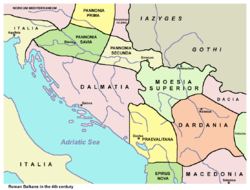
The Illyriciani or Illyrian emperors were a group of Roman emperors during the Crisis of the Third Century who were hailed from the region of Illyricum in the Central Balkans), and were raised chiefly from the ranks of the Roman army (whence they are ranked among the so-called "barracks emperors").
In the 2nd and 3rd centuries, the Illyricum, which included the provinces on the Lower Danube (Dacia, Raetia, Pannonia, Moesia), held the largest concentration of Roman forces (12 legions, up to a third of the total army), and were a major recruiting ground. The advance of these low-born provincials was facilitated by a major shift in imperial policy from the time of Gallienus (253–268) on, when higher military appointments ceased to be exclusively filled by senators. Instead, professional soldiers of humble origin who had risen through the ranks to the post of primus pilus (which also entailed admission to the equestrian order) were placed as heads of the legions and filled the army's command structure.
Since Decius hailed from the senatorial background, the historical period of the Illyrian emperors proper begins with Claudius Gothicus in 268 and continues in 284 with the rise of Diocletian and the institution of the Tetrarchy. This period was very important in the history of the Empire, since it represents the recovery from the Crisis of the Third Century, a long period of usurpations and military difficulties.
The later Valentinian (364-392 and 425–455 AD) also hailed from the Pannonia region.
List
The following emperors are counted as Illyriciani:
- Claudius II, ruled AD 268–270
- Quintillus, ruled AD 270
- Aurelian, ruled AD 270–275
- Probus, ruled AD 276–282
- Diocletian, ruled AD 284–305
- Maximian, ruled AD 286–305
- Constantius I, ruled AD 305–306
- Galerius, ruled AD 305–311
- Severus II, ruled AD 306–307
- Constantine I, ruled AD 306–337
- Licinius, ruled AD 308–324
- Constantius II, ruled AD 337–361
- Jovian, ruled AD 363–364
- Valentinian I, ruled AD 364–375
- Valens, ruled AD 364–378
- Gratian, ruled AD 375–383
- Valentinian II, ruled AD 375–392
- Constantius III, ruled AD 421
- Valentinian III, ruled AD 425–455
- Anastasius I, ruled AD 491–518
- Justin I, ruled AD 518–527
- Justinian I, ruled AD 527–565
- Justin II, ruled AD 565–578
See also the list of Roman emperors for more details.
See also
References
Citations
- ^ Odahl 2004, pp. 36–40.
- Pocock 2015, p. 49.
- Doležal 2022, pp. :2–3: "In a sense, this book is dedicated to the "Illyrian Emperors", i.e. those emperors who were born in the Western Balkans and saved, stabilised, and reformed the empire. This line begins with Claudius II (268— 270) and then moves on to Quintillus (270), Aurelian (270—275), and Probus (276—282).3 After a brief interruption by the reigns of Carus and his two sons (282—284), whose birthplace we do not know, the Illyr-ians continued their run with Diocletian (284—305) and three of his colleagues: Maximian (285—305), Constantius (293—306), and Galerius (293—311). A 4th-century historian said of them: "Illyricum was actually the native land of all of them: so although they were deficient in culture, they had nevertheless been sufficiently schooled by the hardships of the countryside and of military service to be the best men for the state". 4 This is not the end of the Illyrian Emperors: Severus (305—307), Maximinus Daia (305—313), Licinius (308—324), and Constantine himself (306—337) can also be counted among them.".
- Wilkes 1996, pp. 261–263.
- Wilkes 1996, pp. 262–264.
- Wilkes 1996, pp. 262–267.
Sources
- Doležal, Stanislav (2022). The Reign of Constantine, 306–337. Continuity and Change in the Late Roman Empire. Palgrave Macmillan Cham. ISBN 978-3-030-97464-0.
- Pocock, John Greville Agard (2015). Barbarism and Religion. Vol. 6. Cambridge University Press. ISBN 978-1-107-09146-7.
- Odahl, Charles Matson (2004). Constantine and the Christian Empire. Routledge. ISBN 978-0-415-17485-5.
- Wilkes, John (1996) . The Illyrians. Wiley. ISBN 978-0-631-19807-9.
Further reading
- Kuzmanović, Zorica; Mihajlović, Vladimir D. (2015). "Roman Emperors and Identity Constructions in Modern Serbia". Identities: Global Studies in Culture and Power. 22 (4): 416–432.
| Roman emperors by time period | |||||||||
|---|---|---|---|---|---|---|---|---|---|
| |||||||||